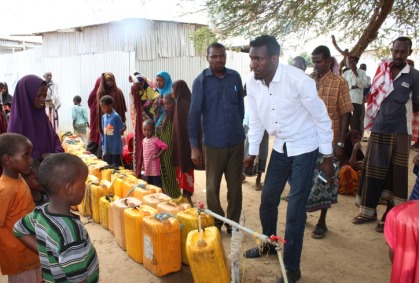Project Duration: 2 years (2017-2018)
Beneficiaries: 7,600 households (HHs)
Location: Sinka Dher (15 km radius)
Funded By: CRS
Date: 2017-2018
Executive Summary
This project report outlines the successful implementation of an emergency response for drought-affected Internally Displaced Persons (IDP) camps in Sinka Dher. The project aimed to provide 60 liters of water per day to 7,600 households across 15 IDP camps for two years. With a budget a substantial budget, the project focused on improving living conditions and reducing the risk of waterborne diseases among the camp residents.
Introduction
Droughts and resulting water shortages are common challenges faced by IDP camps in Sinka Dher, leading to health risks, decreased quality of life, and the exacerbation of existing vulnerabilities. This project sought to address this issue by providing an emergency water distribution system, ensuring a reliable and accessible water supply for 7,600 households across 15 IDP camps.
Project Objectives
- To provide a safe and reliable water source for 7,600 households in 15 IDP camps.
- To improve the overall health and well-being of IDP camp residents.
- To mitigate the impact of drought on vulnerable communities in Sinka Dher.
Scope
The project focused on providing an emergency water distribution system that delivered 60 liters of water per day to each of the 7,600 households in the 15 IDP camps within a 15 km radius of Sinka Dher. The project also included the installation and maintenance of water distribution infrastructure, as well as hygiene education and community engagement to promote sustainable water use.
Methodology
- Assessment: Conduct a needs assessment to identify the most affected IDP camps and determine the required water distribution capacity.
- Procurement: Acquire necessary water distribution equipment, materials, and permits.
- Installation: Install the required infrastructure, such as water storage tanks, pipelines, and distribution points, to facilitate access to water for the targeted households.
- Distribution: Implement a water distribution system that provides 60 liters of water per day to each of the 7,600 households in the 15 IDP camps.
- Hygiene education: Organize hygiene education sessions for camp residents to promote safe water use and reduce the risk of waterborne diseases.
- Community involvement: Engage local residents in the project, fostering a sense of ownership and responsibility, and ensuring the sustainability of the water distribution system.
- Monitoring and evaluation: Assess the project’s impact on the community and gather feedback for future improvements.
Stakeholders
- IDP camp residents: The primary beneficiaries of the water distribution system.
- Local authorities: Government officials responsible for approving permits and overseeing the project.
- CRS: The funding organization for the project.
- Project team: Individuals responsible for planning, implementing, and maintaining the water distribution system.
- Community leaders: Local leaders who supported the project and facilitated community engagement.
Project Timeline
- Year 1: Assessment, procurement, and installation of the water distribution infrastructure.
- Year 2: Water distribution, hygiene education, community involvement, and project monitoring and evaluation.
Resources
The project had a substantial budget , which covered the costs of water distribution equipment, installation, materials, and any necessary permits. Additional resources, such as labor and expertise, were provided by the project team and local authorities.
Results and Outcomes
The project successfully provided 60 liters of water per day to each of the 7,600 households in the 15 IDP camps, improving

